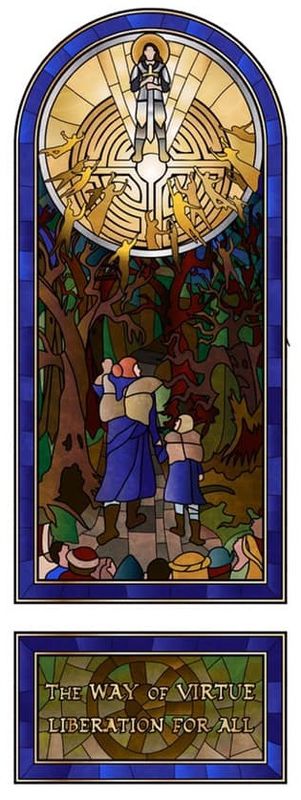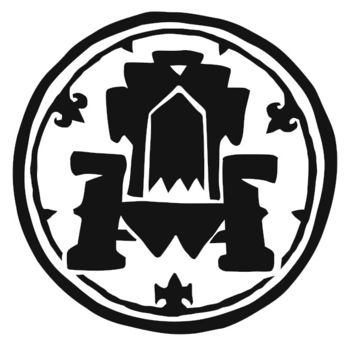383YE Almanac
No edit summary |
|||
| Line 53: | Line 53: | ||
With the Druj already reeling from the ease with which the Imperial forces rescued their people from Zenith, a second bold strategy was hatched between the Spring Archmage and the Prince with a Thousand Foes. | With the Druj already reeling from the ease with which the Imperial forces rescued their people from Zenith, a second bold strategy was hatched between the Spring Archmage and the Prince with a Thousand Foes. | ||
Ever since the Druj return to the Barrens which heralded their renewed assault against the Empire, the people of Dawnguard have been prisoners of the Druj. Under cover of a massed invasion by the armies of Dawn and Varushka, ambitious captains, knights, and their allies stole into the Barrens and rescued as many of their imprisoned Dawnish yeofolk as they could find - along with a significant number of orcs from the various free | Ever since the Druj return to the Barrens which heralded their renewed assault against the Empire, the people of Dawnguard have been prisoners of the Druj. Under cover of a massed invasion by the armies of Dawn and Varushka, ambitious captains, knights, and their allies stole into the Barrens and rescued as many of their imprisoned Dawnish yeofolk as they could find - along with a significant number of orcs from the various free nations that once called the Barrens home. While the Imperial armies were turned back by the Druj, the raids were a triumph that showed the Druj that their dominance of Imperial territory will not go unquestioned. | ||
===Urizeni Resurgence=== | ===Urizeni Resurgence=== | ||
| Line 67: | Line 67: | ||
After much negotiation, Ossium was declared to be part of Varushka, bringing the northern nation to an unprecedented five territories. The Varushkans were quick to exploit their new land – even as the last Druj presence was driven from Ossium settlers began establishing new vales on Bittershore, and in the Galath Fields. | After much negotiation, Ossium was declared to be part of Varushka, bringing the northern nation to an unprecedented five territories. The Varushkans were quick to exploit their new land – even as the last Druj presence was driven from Ossium settlers began establishing new vales on Bittershore, and in the Galath Fields. | ||
The existing population, liberated at last from centuries of oppression by the Druj, have faced challenges of their own. With the assistance of the Synod, the crushing miasma of dread spread by the Druj orcs has been countered. Some of the most tormented people have been offered new homes – the Sand | The existing population, liberated at last from centuries of oppression by the Druj, have faced challenges of their own. With the assistance of the Synod, the crushing miasma of dread spread by the Druj orcs has been countered. Some of the most tormented people have been offered new homes – the Sand Fishers have chosen to quit Ossium entirely and established new settlements in the forests of northern Holberg for example. The extended Ketsov clan – cousins to the new Varushkan settlers – have found ways to increase their prosperity in leaps and bounds thanks to the Empire. | ||
Ossium proves that the Druj, while deadly opponents, are not invincible. They can be beaten; the Mallum can be civilised; and those forced to live under their tyrannical rule can prosper as Imperial citizens once they are freed. | Ossium proves that the Druj, while deadly opponents, are not invincible. They can be beaten; the Mallum can be civilised; and those forced to live under their tyrannical rule can prosper as Imperial citizens once they are freed. | ||
Revision as of 08:14, 8 May 2021
Introduction
The 383YE Almanac has to have been one of the most difficult to compile since the invention of the printing press! With so few pages available to cover the major events of the last year, choosing which events to highlight and in how much detail has been a challenge worthy of the Iron Duke himself.
Not that the people of the League are unfamiliar with difficult challenges of course. The recent curses that have rocked Sarvos and Holberg are proof of that - although it has filled our hearts with Pride to see how the people of those cities have responded to the maledictions placed on their homes by the mortal agents of the wicked Queen of Spite.
Against the Grendel
Across the Bay
For at least the last century, the orcs of Attar and the Broken Shore have held almost uncontested dominance of the waters of the Bay of Catazar. But no more!
The Winter Solstice brought news of the resounding success of the Imperial raid against the city of Dubhtraig. Thousands of soldiers and mariners from all of the Imperial nations launched a daring attack against the domain of the Salt Lord Suriad, burning her palace, destroying the shipyard of Dubhtraig, and freeing thousands of human and orc slaves.
The majority of those orcs have since joined the Imperial Orcs, bringing much needed “fresh blood” to the tenth nation. Reports say that Suriad herself has been slain or deposed, and that the Salt Lords were thrown into disarray by the attack.
The Empire did not rest on its laurels however! In Spring, a second daring raid was launched, inspired by intelligence garnered from those liberated by the attack on Dubhtraig. Another mighty Imperial armada assaulted the eastern city of Beoraidh, targeting a partially constructed fortification and – much more significantly – the training grounds and grand arena that lay outside the city. The fortification was destroyed, and thousands more orc slaves were freed.
The attack has further damaged the Grendel’s ability to replace the catastrophic losses they suffered in their defeat in Spiral and again, the majority of the freed orcs chose to begin new lives among the Imperial Orcs. Indeed, so effective was this raid that the Imperial Orcs could in theory raise a third army once they are able to claim more territory – something that seemed impossible only a year ago.
These two raids demonstrated that the Grendel did not have uncontested dominance of the Bay of Catazar, for all their posturing. In Summer, however, the Empire struck a third hammer-blow against the southern orcs. For several years Grendel pirates have targetted Imperial trading vessels passing through the Bay.
But no longer! Thanks in part to organisation by the Imperial Fleet Master, Imperial captains took to the Bay and routed the Grendel pirate fleet. A combination of careful planning and powerful enchantments allowed the mariners of the Empire not only to drive off or sink the scoundrels harassing honest traders, but also to launch stinging raids against the coastal settlements where the pirates gathered, ensuring the safety of our merchants from the Brass Coast to Urizen.
Fall of Feroz & the Peace Treaty
While Imperial captains have struck against the Grendel at sea, however, the southern orcs have assailed the borders of the Empire itself. Following years of sporadic strikes against settlements along the coast - who can forget the sack of Sarvos or the assault on Atalaya? - the Grendel launched a surprise attack on the Freeborn people of Feroz. Rather than withdrawing at the first sign of Imperial resistance as they have done so many times before, this time they fought to keep the territory they had claimed – and to expand that claim.
Half of Feroz fell to the orc forces despite the valiant efforts of Imperial soldiers to drive them back. So many lives were lost, and many Freeborn were forced to free their homes or submit to the yoke of Grendel slavery. Now the Empire has negotiated a peace treaty with the Salt Lords – but the cessation of hostilities has been purchased at a high price. Control of both Freeborn Feroz and Urizeni Spiral has been ceded to the orcs, and assurances provided that the Empire will build no more shipyards or navies on the Bay of Catazar.
In return the Grendel have agreed to engage in no attacks against the Empire, or against Imperial ship captains, for the next two years and provided assurances of their own that they will provide no assistance to the Druj in their own war against Imperial citizens.
A high price indeed – but one that would likely have been even more punishing without the successes of Imperial captains against the orcs in the months leading up to that negotiation. Will the peace last? The Grendel are greedy and ambitious but just as the Freeborn do, they seem to greatly value their reputation for scrupulousness. Yet to see them ruling over parts of the Brass Coast, and the spires in Spiral, must boil the blood of even the most pragmatic Urizeni and Freeborn citizens.
Against the Jotun
The western orcs - both the true Jotun and their Lasambrian cohorts - continue to wage a war of conquest against the Empire. Their raid against Kharaman was repulsed; their attack against Serra Damata and Serra Briante blocked and then turned back. In the south, the Lasambrian Jotun took early gains due to their surprise attack, but their advance slowed once Imperial troops took up defensive positions and refused to allow them to gain any more territory.
In the north, the year began with a major force moving across the border into Sermersuaq - to challenge Jotun domination of the north-western territory. The fighting was fierce, with many orcs and humans alike slain in the attempt to retake Sealtoq. A battle of honour between Imperial forces and the Jotun below the town of Atalaq during the Winter Solstice saw the orcs abandon the spiritual heart of the Suaq people, and agree to avoid fighting in its streets; the Empire capitalised on these gains to force the orcs back across the Ford of Berussen with the aid of unexpected allies.
Yet there the Imperial advance ground to a halt, leaving the Jotun still in control of the wolf’s share of Sermersuaq. There are stories of resistance to orc rule; of atrocities committed by desperate Winterfolk who it is rumoured have fallen under the influence of fell spirits.
The Winterfolk have refused to rest easy while their people are under orc domination. Shortly before the Autumn Equinox news came of a raid by Imperial captains across the border deep into Sermersuaq. An attack against the mithril mine known as Pride of Ikka’s Tears saw the mine disrupted, and a large amount of mithril recovered.
The Western orcs are not content merely to hold Sermersuaq and parts of far-southern Segura. As the Empire launched its raid in the north, their great host attacked the western marshes of Bregasland, quickly conquering much of the territory. Indeed, were it not for the presence of magical protections raised by the Sussivari Frost Coven, the whole of the peculiar marshy land might have fallen to the orcs.
As it is, their advance was blunted. While a daring engagement between Imperial and Jotun forces near the monastery of Bill Sabbey bought some time for Marchers to prepare their defences for the coming season there is no sign the orcs intend to stop their conquest of Bregasland. If they are successful, they will be in a prime position to strike at the rich farmlands of Mitwold - and perhaps even launch a new attempt to conquer the Mournwold.
During the Winter Solstice the Jotun claimed that a force of Imperials had destroyed the Meeting Place, just beyond the borders of western Sermersuaq. While the stone itself could easily be replaced, this attack may have permanently shattered the long-standing understanding between Jotun and Winterfolk. Imperial efforts to repair the rock itself continue to be rebuffed - the orcs claim that restoring trust with their Imperial neighbours is not as simple as rebuilding a piece of stone.
Against the Druj
Can there be any barbarian nation more pernicious than the Druj? Of all the enemies of the Empire they seem to take the greatest joy in cruelty and slaughter for its own sake. The entire territory of Zenith still labours under the oppression yoke of Druj domination, as do those parts of Spiral not ceded to the Grendel.
With the devastating loss of the Halls of Knowledge, it may have seemed that the Druj invasion of Morrow would go the same way as that of Zenith - with the courageous Imperial defenders forced to give ground. Yet the Winter Solstice saw the orc schemes in tatters. A great force of Imperial soldiers, supported by potent supernatural allies, stemmed the orc advance in the Battle of Canterspire. By the Spring Equinox, the Druj were driven out of Morrow entirely, forced to retreat back into Zenith in disarray.
Yet the Empire was not finished. At the same time the armies were fighting in Morrow, a courageous force of Imperial captains launched a daring raid into Zenith. Lead by Urizen sentinels and Highborn scouts, and with the support of the heralds of the Celestial Library, these captains were able to strike at key locations across the conquered territory freeing large numbers of Urizen and Highborn prisoners and seeing them escorted to safety in Morrow and Redoubt – from right under the noses of their Druj captors.
With the Druj already reeling from the ease with which the Imperial forces rescued their people from Zenith, a second bold strategy was hatched between the Spring Archmage and the Prince with a Thousand Foes. Ever since the Druj return to the Barrens which heralded their renewed assault against the Empire, the people of Dawnguard have been prisoners of the Druj. Under cover of a massed invasion by the armies of Dawn and Varushka, ambitious captains, knights, and their allies stole into the Barrens and rescued as many of their imprisoned Dawnish yeofolk as they could find - along with a significant number of orcs from the various free nations that once called the Barrens home. While the Imperial armies were turned back by the Druj, the raids were a triumph that showed the Druj that their dominance of Imperial territory will not go unquestioned.
Urizeni Resurgence
While Urizen has suffered great losses at the hands of the Druj things in the south-east finally seem to be turning around. With the establishment of the Doyen of the Spires, and the creation of Urizen Lore, it seems that the tragedy of the Druj invasion has lead to widespread changes for the nation in the coming years. Using the newly restored Heliopticon the legacy of the Halls of Knowledge has been expanded to unprecedented levels, allowing the entire nation to cooperate on the codification of magical rituals. With the aid of the eternal Phaleron, the Urizeni have begun the creation of a national body of magical knowledge that might one day rival Imperial Lore itself.
Finally, on the slopes of southern Morrow, the Three Watchers have been carved from the living stone. Commemorating the courage of the Highborn armies as they oversaw the evacuation of Zenith, this great monument now watches as the armies of the Empire move into Zenith to free the territory from the cruel dominion of the Mallum orcs.
The Conquest of Ossium
The Winter Solstice brought a great victory for the Empire in the north-east as the Druj territory of Ossium was finally brought under Imperial control. Ever since the armies of Dawn marched across the Golden Causeway from Semmerholm to meet their Varushkan and Thule allies in the north, the Imperial presence in Ossium has gone from strength to strength.
With the Druj in retreat, and the majority of the damp forests of Ossium liberated, the Senate debated which Imperial Nation would be assigned responsibility for the first completely new territory claimed by the Empire since the conquest of Segura almost exactly two centuries ago.
After much negotiation, Ossium was declared to be part of Varushka, bringing the northern nation to an unprecedented five territories. The Varushkans were quick to exploit their new land – even as the last Druj presence was driven from Ossium settlers began establishing new vales on Bittershore, and in the Galath Fields.
The existing population, liberated at last from centuries of oppression by the Druj, have faced challenges of their own. With the assistance of the Synod, the crushing miasma of dread spread by the Druj orcs has been countered. Some of the most tormented people have been offered new homes – the Sand Fishers have chosen to quit Ossium entirely and established new settlements in the forests of northern Holberg for example. The extended Ketsov clan – cousins to the new Varushkan settlers – have found ways to increase their prosperity in leaps and bounds thanks to the Empire.
Ossium proves that the Druj, while deadly opponents, are not invincible. They can be beaten; the Mallum can be civilised; and those forced to live under their tyrannical rule can prosper as Imperial citizens once they are freed.
Invasion of Holberg
Five years ago the Malum orcs were driven out of Holberg; shortly before the Autumn Equinox they returned. Even as the city laboured under the curse that destroyed the beautiful gardens of Holmaur, the Druj were establishing a presence in the eastern forests. Their intention was to hunt and kill the Sand Fishers offered sanctuary in Misericorde. If not for the intervention of Imperial heroes using the Sentinel Gate, it seems likely they would have succeeded. For now, their ambitions have been thwarted - but there is still a major armed force in the eastern forests and it is surely only a matter of time before they try again.
Against the Vallorn
Battle of Brocéliande
Throughout 383YE, the Empire has been at war in the forest of Brocéliande. It began in late Autumn, when Navarr scouts reported a dangerous rise in vallorn activity in the territory even as the vallorn in Liathaven was being beaten back. Two regions of Brocéliande remained free of vallorn infestation, and it seemed the dreadful vegetable horror sought to reclaim both Elerael and Boar’s Dell.
As the year progressed, it became clear that this was not some random increase in vallorn activity but something much more sinister, guided and encouraged by servants of the deadly eternal Yaw’nagrah and her treacherous mortal allies.
Yet the Navarr defenders were not without allies of their own. The questing knights and knights errant of Dawn rallied to the cause to defend their friends in Boar’s Dell, while the priests and pilgrims of Highguard sent significant aid to the beleaguered inhabitants of Elerael in the form of pious warriors and valuable supplies. At the same time, independent captains came from across the Empire to fight in Brocéliande, to help the Navarr living there preserve their homes. Arrayed against them, mysterious traitors - many of them with briar lineage - working hand-in-hand with the servants of the eternal Yaw’nagrah to urge the vallorn of Brocéliande to wakefulness.
The strength of the vallorn increased season-on-season until the nascent disaster culminated in a great push in the lead-up to the Autumn equinox. With allies both mortal and eternal, the Navarr were able to hold their own against the tide of green destruction and drive it back – weakening the vallorn sufficiently that it may soon prove possible to clear its malign presence from Dark Ranging as well.
Victory in Brocéliande has come at a price, however. The Navarr laid a powerful curse of Winter magic across the territory to help slow and weaken the vallorn advance, and that curse has long-term implications for the people living there and their ability to prosper for at least a generation. Perhaps even more contentiously, that victory was apparently bought with the assistance of the Druj; five thousand hated orcs from the Mallum fought the vallorn in Brocéliande. While many have turned a blind eye to this new alliance between the Navarr and the Druj, the eastern orcs do nothing that does not serve their own interests in some way.
Liberation of Liathaven
Brocéliande is not the first place that Yaw’nagrah and her allies have sought to cause trouble. In 381YE, they were involved in an attempt to push the vallorn of Liathaven to spread northward into West Ranging. At great cost, the Navarr and their Marcher allies held the line against the vallorn and pushed it back – creating an opportunity to strike back against the weakened vallorn.
In Summer this year, that strike fell and the vallorn was driven out of the West Wood. For the first time since the fall of Terunael it is possible to travel from the Marches to the Brass Coast through Liathaven without the threat of the Vallorn. In the process, a great treasure was uncovered – an untouched forest of weirwood trees that had endured the touch of the vallorn unchanged for a thousand years.
The defeat of the vallorn in Liathaven represents a major victory for the Empire, but the territory remains contested between the Empire and the Jotun orcs. The forests also labour under the same powerful Winter curse as Brocéliande, and following the resolution of the Mournwold situation, an unknown number of Feni have settled the forests of Liathaven.
Heirs of Terunael
Even as the Navarr were victorious in Brocéliande, however, their enemies changed target. The so-called Heirs of Terunael – allies of Yaw’nagrah who seem hellbent on seeing the vallorn devour the entire Navarr nation – launched attacks in Liathaven, Hercynia, and Therunin. If not for the timely assignment of the Silent Bell to investigate their activities, the Empire might have been taken by surprise. As it is, the activities of these Heirs and their allies were uncovered in the nick of time, allowing the Empire to potentially intercede and block their attempts to ravage Hercynia and Therunin, and further complicate the chaos in Liathaven.
Rise of the Grey Pilgrims
The Grey Pilgrims were formed In response to the spiritual threat posed by the Vallorn. Drawn from those members of the Highborn nation prepared to commit everything to the war, and following the Navarr example, they have taken to walking the trods in large numbers. This new pilgrimage has come at great cost, but a decision by the Empire to support the Highborn meant that they were not required to bear this cost alone.
As they have travelled the trods, the Grey Pilgrims have continued to develop their role in the Empire, and in the nation of Highguard. Throughout 383YE, the Pilgrims’ mandate to seek out heresy, blasphemy, and idolatry was explored. Unfortunately, this exploration lead to conflict with almost all the nations of the Empire. In the end, the General Assembly of the Synod intervened, declaring that the various idiosyncratic practices of individual nations were acceptably orthodox. This brought the growing confusion to an end for all human nations save one.
The exception was Dawn, who took a very different approach. After the Summer Solstice, the Dawnish assembly encouraged troubadours to visit Highguard and show them that love and glory were not incompatible with the virtues. Highguard welcomed the Dawnish priests, and as the Winter approached the two nations’ assemblies seem to have become closer than ever before.
Signing the Liberty Pact
The development with the widest-ranging impact was the signing of the Liberty Pact over the Winter Solstice. After several years of groundwork by multiple ambassadors, representatives of the Commonwealth, the Sumaah Republic, the Sarcophan Delves and the Citadels of Axos came together to conclude negotiations for this historic document. By the end of the summit, all the five nations save Sarcophan, had become signatories, opposing slavery throughout the known world.
The success of the Liberty Pact has improved relations with the rival nation of Sumaah a little. While they still refuse to return the Imperial Crown, the port of Zemeh is again open to Imperial traders - and their grand capital of Timoj has been opened to foreign pilgrims for the first time. Sumaah missionaries have stopped agitating against the Synod - at least for the moment - and an unprecedented Symposium is scheduled for the Winter Solstice during which the priests of the two nations will debate the issues that threaten to split the faithful across the world.
Relations with the Commonwealth have improved even more significantly, with the Conclave going so far as to offer access to the whole of Imperial lore to any magician prepared to make the trip to the Empire to study. This move has, needless to say, had serious negative consequences for the Empire’s already shaky relations with the Principalities of Jarm.
The further decline in relations with Jarm is only one of the repercussions of the Liberty Pact. As a signatory, the Empire agreed to impose significant trade tariffs on nations that continue to employ slave labour. This has had a deleterious effect on diplomatic relations with many of the Empire’s trading partners including the Asavean Republic, the Principalities of Jarm, and – closer to home – the Faraden, the Iron Confederacy, and the Thule.
Relations with Asavea in particular are in turmoil, with Imperial mercenaries fighting on both sides of the recent civil war that rocked the distant republic. The imposition of tariffs angered the Plenum, but news of the Synod-inspired defacement of the works of idolatrous architect Almodin Oktístis lead to in an outraged mob attacking the Temple of the Way in Nemoria. The building was severely damaged, and several of the priests in attendance were badly hurt, one fatally. The Plenum claims to have punished those responsible, but it seems likely relations between the two nations will continue to struggle.
Still, on a much more positive note, as signatories to the pact the people of Axos have finally criminalised the enslavement of humans and orcs. After years of pressure from the Senate and the Synod, the intervention of the Empire has been directly responsible for their movement toward a more civilised nation.
The Disappearance
Yet for many, the most significant event of the last year is the disappearance of the Throne, Imperatrix Lisabetta Giacomi von Holberg and her consort, the Imperial Magus Juha the Cave Spider. All that is known for certain is that they retired together on the evening of the Summer Solstice and that come the morning their bedchamber was empty. After some consideration, the Constitutional Court ruled that the Imperial Throne was now empty.
Needless to say, rumour and speculation are rife. There is talk of peculiar magical rituals, of true liao, and of secret conspiracies aimed at the Throne. Has there been a concerted attempt to cover-up and conceal the facts of the disappearance? Was the Empress assassinated? Scholars have pointed out that Lisabetta sat upon the throne for only three years - just like both Empress Britta and Emperor Walter before her. Coincidence? Perhaps we will never know for sure.
Challenges to Come
The disappearances have come at a difficult time for the Empire.
While a peace treaty may have been secured with the Grendel, the Jotun continue their efforts to conquer the western Empire and the Druj still hold much of Urizen. Does the Empire have the strength to drive them back?
There are Great Forest Orcs settling in Therunin, Jotun Thralls thriving in the Mourn, Sand Fishers setting up home no more than a handful of leagues from the Empress’ own home in Holberg. What role will the Empire find for these strangers?
The Empire has committed to another ambitious strike against the Malum, with Imperial forces moving from Ossium to assail the Forest of Ulnak. What horrors will they face there?
The Heirs of Terunael are poised to strike deep within Imperial borders, potentially initiating widespread destruction among the Navarr. Can their plans be thwarted?
With the implications of the Liberty Pact becoming clear, those nations insistent on the cruel practice of slavery begin to form a coalition of their own. What will this mean for Imperial diplomats?
With the Throne gone it falls to us all to take up the torch; to face the challenges of the coming year; and to overcome everything our enemies throw at us!




